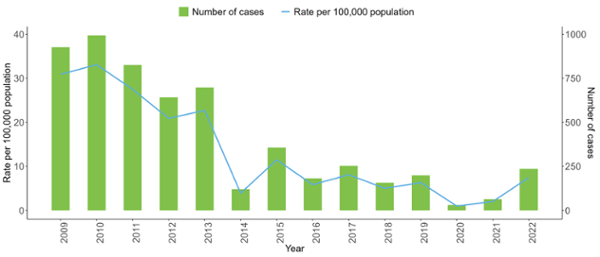Rotavirus surveillance and epidemiology
Rotavirus infection causes acute gastroenteritis. It generally occurs in a seasonal pattern and affects mainly infants and young children, occurring mostly in winter and early spring. Symptoms include vomiting, fever and watery diarrhoea. Symptoms usually last three to eight days.
Before the introduction of the vaccine rotavirus was the main cause of hospitalisation for gastroenteritis in infants in the UK. In the UK an estimated 300,000 episodes of rotavirus gastroenteritis occured each year in children less than five years, with approximately 12,700 hospitalisations (Djuretic et al 1999, Ryan et al 1996). Although mortality is low with adequate supportive treatment, it may be fatal where rehydration is not available. Spread is mainly faecal-oral person to person. Almost all children have experienced an episode by five years of age. The number of reported cases of rotavirus has reduced by over 70% since the introduction of the vaccine into the UK childhood programme.
Rotavirus in Wales
Chart showing the rate per 100,000 population and number of confirmed cases of rotavirus in Wales from 2000-2022

Rate per 100,000 population and number of confirmed cases of rotavirus in Wales from 2009-2022
| Year | Number of cases | Rate per 100,000 population |
|---|---|---|
| 2009 | 927 | 30.90 |
| 2010 | 994 | 33.10 |
| 2011 | 826 | 27.50 |
| 2012 | 642 | 20.90 |
| 2013 | 698 | 22.70 |
| 2014 | 121 | 3.91 |
| 2015 | 356 | 11.49 |
| 2016 | 182 | 5.85 |
| 2017 | 253 | 8.10 |
| 2018 | 157 | 5.00 |
| 2019 | 199 | 6.31 |
| 2020 | 31 | 0.98 |
| 2021 | 64 | 2.02 |
| 2022 | 236 | 7.45 |
Confirmed cases of rotavirus in Wales by age 2009-2022
| Year | <1 | 1-4 | 5-14 | 15-24 | 25-34 | 35-44 | 45-64 | 65+ | Unknown | All ages |
|---|---|---|---|---|---|---|---|---|---|---|
| 2009 | 357 | 510 | 28 | 0 | 3 | 3 | 4 | 18 | 4 | 927 |
| 2010 | 385 | 560 | 19 | 2 | 2 | 0 | 4 | 1 | 21 | 994 |
| 2011 | 278 | 516 | 12 | 1 | 0 | 0 | 2 | 1 | 16 | 826 |
| 2012 | 241 | 384 | 6 | 1 | 0 | 0 | 4 | 3 | 3 | 642 |
| 2013 | 245 | 440 | 11 | 0 | 0 | 0 | 0 | 1 | 1 | 698 |
| 2014 | 25 | 95 | 0 | 0 | 1 | 0 | 0 | 0 | 0 | 121 |
| 2015 | 51 | 290 | 13 | 0 | 0 | 2 | 0 | 0 | 0 | 356 |
| 2016 | 41 | 125 | 11 | 0 | 0 | 1 | 2 | 2 | 0 | 182 |
| 2017 | 62 | 167 | 16 | 0 | 0 | 1 | 0 | 7 | 0 | 253 |
| 2018 | 40 | 108 | 9 | 0 | 0 | 0 | 0 | 0 | 0 | 157 |
| 2019 | 31 | 151 | 15 | 1 | 0 | 0 | 0 | 1 | 0 | 199 |
| 2020 | 16 | 14 | 0 | 1 | 0 | 0 | 0 | 0 | 0 | 31 |
| 2021 | 29 | 32 | 2 | 0 | 1 | 0 | 0 | 0 | 0 | 64 |
| 2022 | 49 | 171 | 14 | 0 | 0 | 0 | 1 | 1 | 0 | 236 |
Confirmed rotavirus cases in 2018-2022 by quarter of onset
| Quarter | Number of cases in 2018 | % of 2018 year total | Number of cases in 2019 | % of 2019 year total | Number of cases in 2020 | % of 2020 year total | Number of cases in 2021 | % of 2021 year total | Number of cases in 2022 | % of 2022 year total |
| Jan-Mar | 27 | 17.2 | 59 | 29.6 | 13 | 41.9 | 12 | 18.8 | 68 | 28.8 |
| Apr-Jun | 56 | 35.7 | 103 | 51.8 | 5 | 16.1 | 20 | 31.2 | 92 | 39 |
| Jul-Sep | 43 | 27.4 | 26 | 13.1 | 10 | 32.3 | 15 | 23.4 | 62 | 26.3 |
| Oct-Dec | 31 | 19.7 | 11 | 5.5 | 3 | 9.7 | 17 | 26.6 | 14 | 5.9 |
Immunisation against rotavirus
The rotavirus vaccine is given to babies as part of their routine childhood immunisations. It is given as two doses when a baby is two and three months old.
Uptake and coverage of all recommended childhood immunisations are monitored and reported by Public Health Wales quarterly and annually at local and national levels in the COVER (Coverage of Vaccination Evaluation Rapidly) report. This is published on both a quarterly and annual basis.
A study was presented at ESCAIDE in 2017 on the impact of the introduction of the rotavirus vaccine in reducing health inequalities in GP gastrointestinal consultation rates in children under 5 in Wales: European Scientific Conference on Applied Infectious Disease Epidemiology 2016 (page 104).